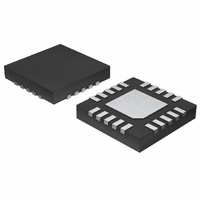MAX4411ETP+ Maxim Integrated Products, MAX4411ETP+ Datasheet - Page 11

MAX4411ETP+
Manufacturer Part Number
MAX4411ETP+
Description
IC AMP AUDIO .08W STER AB 20TQFN
Manufacturer
Maxim Integrated Products
Series
DirectDrive™r
Type
Class ABr
Datasheet
1.MAX4411EBET.pdf
(18 pages)
Specifications of MAX4411ETP+
Output Type
Headphones, 2-Channel (Stereo)
Max Output Power X Channels @ Load
80mW x 2 @ 16 Ohm
Voltage - Supply
1.8 V ~ 3.6 V
Features
Depop, Short-Circuit and Thermal Protection, Shutdown
Mounting Type
Surface Mount
Package / Case
20-TQFN Exposed Pad
Product
General Purpose Audio Amplifiers
Output Power
80 mW
Thd Plus Noise
0.007 %
Operating Supply Voltage
1.8 V to 3.6 V
Supply Current
3.2 mA
Maximum Power Dissipation
1349 mW
Maximum Operating Temperature
+ 85 C
Mounting Style
SMD/SMT
Minimum Operating Temperature
- 40 C
Supply Voltage (max)
3.6 V
Supply Voltage (min)
1.8 V
Amplifier Class
AB
No. Of Channels
2
Supply Voltage Range
1.8V To 3.6V
Load Impedance
16ohm
Operating Temperature Range
-40°C To +85°C
Amplifier Case Style
TQFN
Rohs Compliant
Yes
Lead Free Status / RoHS Status
Lead free / RoHS Compliant
The combination of low-frequency attenuation and fre-
quency-dependent distortion compromises audio repro-
duction in portable audio equipment that emphasizes
low-frequency effects such as multimedia laptops, as
well as MP3, CD, and DVD players. By eliminating the
DC-blocking capacitors through DirectDrive technology,
these capacitor-related deficiencies are eliminated.
The MAX4411 features a low-noise charge pump. The
320kHz switching frequency is well beyond the audio
range, and thus does not interfere with the audio sig-
nals. The switch drivers feature a controlled switching
speed that minimizes noise generated by turn-on and
turn-off transients. By limiting the switching speed of the
charge pump, the di/dt noise caused by the parasitic
bond wire and trace inductance is minimized. Although
not typically required, additional high-frequency noise
attenuation can be achieved by increasing the size of
C2 (see Typical Application Circuit).
The MAX4411 features two shutdown controls allowing
either channel to be shut down or muted independently.
SHDNL controls the left channel while SHDNR controls
the right channel. Driving either SHDN_ low disables
the respective channel, sets the driver output imped-
ance to 1kΩ, and reduces the supply current. When
both SHDN_ inputs are driven low, the charge pump is
also disabled, further reducing supply current draw to
Figure 4. Distortion Contributed by DC-Blocking Capacitors
duced by two different capacitor dielectric types.
Note that below 100Hz, THD+N increases rapidly.
0.0001
0.001
0.01
0.1
10
1
10
______________________________________________________________________________________
TO DC-BLOCKING CAPACITORS
ALUM/ELEC
ADDITIONAL THD+N DUE
100
80mW, Fixed-Gain, DirectDrive, Stereo
FREQUENCY (Hz)
TANTALUM
Headphone Amplifier with Shutdown
1k
10k
Charge Pump
Shutdown
100k
6µA. The charge pump is enabled once either SHDN_
input is driven high.
In conventional single-supply audio drivers, the output-
coupling capacitor is a major contributor of audible
clicks and pops. Upon startup, the driver charges the
coupling capacitor to its bias voltage, typically half the
supply. Likewise, on shutdown, the capacitor is dis-
charged to GND. This results in a DC shift across the
capacitor, which in turn, appears as an audible transient
at the speaker. Since the MAX4411 does not require
output-coupling capacitors, this does not arise.
Additionally, the MAX4411 features extensive click-and-
pop suppression that eliminates any audible transient
sources internal to the device. The Power-Up/Down
Waveform in the Typical Operating Characteristics
shows that there are minimal spectral components in the
audible range at the output upon startup or shutdown.
In most applications, the output of the preamplifier dri-
ving the MAX4411 has a DC bias of typically half the
supply. At startup, the input-coupling capacitor is
charged to the preamplifier’s DC-bias voltage through
the R
the capacitor and an audible click/pop. Delaying the
rise of the SHDN_ signals 4 to 5 time constants (80ms
to 100ms) based on R
of the preamplifier, eliminates this click/pop caused by
the input filter.
Under normal operating conditions, linear power ampli-
fiers can dissipate a significant amount of power. The
maximum power dissipation for each package is given
in the Absolute Maximum Ratings section under
Continuous Power Dissipation or can be calculated by
the following equation:
where T
ture, and θ
°C/W as specified in the Absolute Maximum Ratings
section. For example, θ
+59.3°C/W.
The MAX4411 has two power dissipation sources, the
charge pump and the two drivers. If the power dissipa-
tion for a given application exceeds the maximum
allowed for a given package, either reduce V
increase load impedance, decrease the ambient tem-
perature, or add heatsinking to the device. Large
F
of the MAX4411, resulting in a DC shift across
J(MAX)
JA
P
DISSPKG MAX
is the reciprocal of the derating factor in
is +150°C, T
Applications Information
Click-and-Pop Suppression
(
IN
and C
)
JA
=
A
T
of the QFN package is
J MAX
is the ambient tempera-
IN,
(
Power Dissipation
θ
relative to the startup
JA
)
−
T
A
DD
11
,










